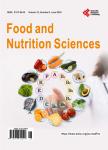Brazilian Maize Landraces Silks as Source of Lutein: An Important Carotenoid in the Prevention of Age-Related Macular Degeneration
Brazilian Maize Landraces Silks as Source of Lutein: An Important Carotenoid in the Prevention of Age-Related Macular Degeneration作者机构:Biochemistry and Animal Morphophysiology Laboratory Departament of Zootechny and Rural Development CCA Federal University of Santa Catarina (UFSC) Florianopolis-SC Brazil Laboratory of Studies in Bioactivity and Animal Morphogenesis Departament of Cell Biology Embriology and Genetics CCB Block-D Federal University of Santa Catarina (UFSC) Florianopolis-SC Brazil Plant Morphogenesis and Biochemistry Laboratory CCA Federal University of Santa Catarina (UFSC) Florianopolis-SC Brazil. Studying Group in Agricultural Biodiversity Departament of Phytotechny CCA Federal University of Santa Catarina (UFSC) Florianopolis-SC Brazil
出 版 物:《Food and Nutrition Sciences》 (食品与营养科学(英文))
年 卷 期:2012年第3卷第11期
页 面:1609-1614页
学科分类:1002[医学-临床医学] 100214[医学-肿瘤学] 10[医学]
主 题:Lutein Maize Landraces Silks
摘 要:The carotenoid composition of the silk tissue of Zea mays (L.) has not been investigated despite its large occurrence in maize grains. For the purpose of evaluating maize silk as a source of carotenoids, samples from eight landraces developed and cultivated in Southern Brazil were assayed. The silk samples were harvested from individual plants through the fourth and seventh day after they emerged, frozen in liquid N2, and lyophilized. The carotenoids were extracted with a MeOH/toluene solution (1:1, v/v), 30 min, and saponified (15% KOH, 12 h, 40℃). The RP-HPLC-UV-visible analysis revealed lutein as the main carotenoid (88.75%) in maize silks, with a wide range of contents (dry weight), i.e. 39.11 ?g?g-1 (Palha Roxa 18) to 176.12 ?g?g-1 (Língua de Papagaio) among the studied genotypes. Smaller amounts of trans-β-carotene, α-carotene, and zeaxanthin were also detected. The results revealed that in parallel to the claimed high genetic variability of maize landraces, a quite variable carotenoidic composition of silk tissue seems to occur in the germoplasm cultivated in Southern Brazil. Taking into account the usage of lutein for the prevention of several pathologies, especially the age related macular degeneration, some maize landraces (e.g. Língua de Papagaio and Rosado) might be interesting sources of a lutein-rich extract that could add value to an underutilized biomass.



